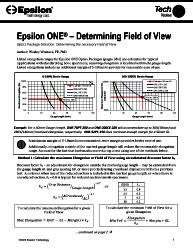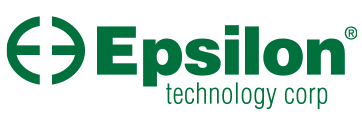
Epsilon’s Tech Notes provide detailed technical information about extensometer applications and best practices for strain measurement. The Tech Notes complement the General Information manual and model-specific manuals supplied with every extensometer. Tech Notes for specialized extensometers are also available.
Some Tech Notes are not downloadable but are available to verified customers on request.

General Topics
General Information Manual
General information about procedures, precautions, and how to calibrate strain-gaged extensometers.
➞ How do I calibrate a strain-gaged extensometer?
Gauge Length and Measuring Range
Understanding basic extensometer parameters, and selecting an appropriate instrument.
➞ What do gauge length and measuring range mean when selecting an axial extensometer?
Limited Measuring Range
A discussion of common causes of unexpected limits to an extensometer’s measuring range.
➞ Why did my extensometer stop measuring halfway through the test?
Tethering
Prevent extensometer damage and improve test results on sensitive specimens using tethering.
➞ How can I support the weight of the extensometer when testing delicate specimens?
➞ How do I prevent damage to an extensometer if it falls off of the specimen?
Extensometer Slippage
Identifying and mitigating contact-point slippage of an extensometer
➞ What can cause strange saw-blade effects in my stress-strain curve when using an extensometer?
➞ How do I stop my extensometer from slipping?
Handling Sensitivity
Distinguishing typical sensitivity to manipulation from extensometer damage.
➞ Why is there noise when I move the cable?
Extensometers for Lap Shear Testing
Best practices selecting and using extensometers for lap shear testing.
➞ What are some extensometer options for lap shear testing?
Installing Connectors
Guidance for installing aftermarket connectors on Epsilon Extensometers.
➞ How do I install a connector myself?
Bulkhead Connectors
Recommended practices for using strain-gaged transducers with bulkhead connectors in testing chambers.
➞ What kind of connectors should I use when my testing chamber has a bulkhead?
Interfacing with Extensometers
Guidance for connecting extensometers with common Data Acquisition (DAQ) systems.
➞ How does the extensometer connect to my testing machine?
➞ What should I do if my machine doesn’t have suitable inputs?
Calibration and Verification
Spot Check Verification
Quickly check for common errors in math, data entry, and calibration.
➞ Is there a quick way to determine if my measurements and calculations are approximately correct?
Gauge Length and Calibration
Ensuring accurate measurement results when reconfiguring an extensometer.
➞ Does the extensometer measure strain or elongation?
➞ What is the gauge length of a deflectometer or COD?
➞ Do I need to recalibrate the extensometer if I use a gauge length adapter?
When to Verify
Guidance for ensuring accuracy and determining when to reverify your extensometer system.
➞ How do I ensure accuracy after making a change?
➞ How do I ensure accuracy after a period of time has passed?
➞ What is a typical verification schedule?
➞ Do I need to reverify after replacing consumable parts?
Interpreting Common Verification Problems
A visual inspection of graphical verification results can reveal much more than a raw numerical table of results. Common problems in the extensometer verification process are discussed.
➞ My extensometer did not meet specification; what is the problem?
Verification – Fixed and Relative Errors
Understanding the fixed and relative bias error requirements of standards ASTM E83 and ISO 9513, and a discussion of common ill-posed accuracy requirements.
➞ What is the accuracy of the extensometer, and will it meet an accuracy of XX%?
Verification Range
The accuracy class of an extensometer may vary by measurement range and gauge length. This is particularly important when evaluating high elongation or variable gauge length systems.
➞ What is the verified measuring range, and what if I want to use the extensometer outside the range on the test certificate?
➞ What is the accuracy of an adjustable / variable gauge length extensometer?
Calibration Gain Optimization
Getting the best performance out of your extensometer. If your measurement error is increasing or decreasing proportionally with displacement, you may need to adjust or repeat your calibration.
➞ What is shunt calibration, and does it prevent me from ever needing an on-site calibration?
Transverse Calibration Best Practices
Using the right calibration equipment and process will help avoid difficulties.
➞ My Poisson’s ratio or r-values do not match expected values; what is wrong with my transverse extensometer?
Extensometer “Gage Factors”
Using extensometers with data acquisition systems designed for use with strain gages.
➞ How do I use an extensometer with a strain-gage conditioner or Wheatstone Bridge amplifier?
Extensometer Calibration and Installation Guides for Specific Testing Systems and Software
Get instructions that are specifically for the brand of testing system you use.
Thermal Effects and Non-Ambient Testing
Understanding Thermal Drift
Daily variation in environmental temperature can cause measurement drift.
➞ My extensometer output is drifting; what is a possible cause of this?
Understanding Warmup Drift
Allow electronics to stabilize after powering on before use or calibration.
➞ My extensometer drifts when I first connect it. What is happening?
Temperature Sensitivity Compensation
Using and understanding adjustments to extensometer sensitivity at non-ambient temperatures.
➞ Does my room temperature calibration apply to the extensometer’s full temperature range?
Cryogenic Thermomechanical Noise
Mitigating elevated noise in cryogenic applications.
➞ I am using my extensometer at cryogenic temperatures and the output is noisy. What could be the cause of this?
High-Temperature Thermomechanical Noise
Mitigating elevated noise in high temperature applications.
➞ I am using my extensometer at elevated temperatures and the output is noisy. What could be the cause of this?
Dynamic Temperature Applications
Using extensometers in applications with variable temperature is challenging and requires careful consideration.
➞ I am using my extensometer in a test environment where the temperature is changing as part of my test, but within the usable temperature range of the extensometer. The strain output is not as I expect. What could be the problem?
Optimizing Test Results and Data Quality
Test Curve Nonlinearity
Identifying and resolving common causes of test curve nonlinearity and other curve quality problems.
➞ My stress-strain curve does not look like I expect it would. What could be the problem?
Resolution and Noise
Interpreting and optimizing signal quality.
➞ What is the resolution of an Epsilon extensometer? How can I improve it?
Nonuniform Yielding
Various common yield point phenomena can cause unexpected test curves.
➞ The stress-strain curve is not as I would expect within the region of yielding. What could be the problem?
Basic Signal Filters
Optimizing signal quality using common filter methods.
➞ How can I reduce my signal noise?
Cyclic Drift
Measurement drift in cyclic applications has many causes and can be challenging to resolve.
➞ I am running a cyclic test, and the output seems to drift. What could be the problem?
Regression Bias
An often-overlooked mathematical complication can bias slope estimation of noisy or out-of-phase data.
➞ My test data is noisy and the modulus is not being calculated correctly by my software. What could be the problem?
Strain Control Basics
Strain-controlled testing applications present unique challenges. Strain control systems are often poorly understood and may yield unexpected results.
➞ Can Epsilon extensometers be used for strain control testing?
➞ How can I get good results in strain-control?
Model-Specific Tech Notes
Model 7641: Thin CT Specimens
Clevis design strategies for accommodating specimens narrower than your COD gage
➞ How do I fit a COD gage on a narrow / thin CT specimen?
Model 3544
Correcting for specimen diameter with circumferential extensometer model 3544.
➞ I want to use a 3544 circumferential extensometer to test samples of varying diameters. Is the calibration valid for all specimen diameter ranges?
Model 4013
Calculating shear strain with the model 4013 lap shear extensometer.
➞ How do I calculate shear strain?
Models 764x, 765x: Signal Filtering
Configuring DT6229 Filter Settings using the built-in web interface.
➞ How do I configure Filter Settings using a DT6229?
Models 764x, 765x: Output Linearization
Capacitive extensometer linearization with model DT6229 electronics.
➞ I need to re-linearize my capacitive transducer with the DT6229; do you have a guide?
Axial-Torsional Models 3550, 3550HT, 7650
How to interpret torsional strain data and calculate shear strain when using axial-torsional extensometers.
➞ How do torsion-measuring extensometers work?
Transverse Models 3475, 3575, 3575AVG
Using the right equipment and process will help you avoid unforeseen difficulties.
➞ My Poisson’s ratio or r-values do not match expected values; what is wrong with my transverse extensometer?
Models LE-05, LE-15
Setting up and verifying initial serial communication with LE-05 and LE-15 laser extensometers.
➞ How do I read LE output through a digital connection?
Model Epsilon ONE®: Model Selection
Selecting the best Epsilon ONE non-contact extensometer for your application.
Model Epsilon ONE®: Determining Field of View
Determining the necessary Field of View when selecting an optics package.
Model Epsilon ONE®: Telecentric and Conventional Optics
Understanding precision telecentric and conventional optics, and their significance for small-strain testing.
Model Epsilon ONE®: Testing High-Elongation Materials
Recommended methods when testing with the highest elongation materials.
Model Epsilon ONE®: Testing with Environmental Chambers
Considerations when using non-contact extensometers with environmental chambers and windows.
Model Epsilon ONE®: Verification
Best Practices when calibrating and verifying Epsilon ONE non-contact extensometers.
Model Epsilon ONE®: Getting Started – User Interface Software
Getting started with the Epsilon ONE’s user interface software.
Model Epsilon ONE®: High-Speed Digital Interface
Using the high-speed digital stream method with Epsilon ONE.
Repairs/Service
If your unit is in need of service, calibration or repair, initiate the RMA process with us and we will be happy to assist.
Get Our Newsletter
Sign up for our newsletter to get the most up-to-date information on products and services.
Download Catalog
Our 2022 Extensometer Catalog, Version 110 is now available! Not finding something you’re looking for? Ask us about a custom quote.
